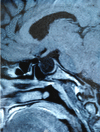Association of an empty sella and grave´s disease in a patient with acromegaly: a case report
- PMID: 34381538
- PMCID: PMC8325439
- DOI: 10.11604/pamj.2021.38.394.25034
Association of an empty sella and grave´s disease in a patient with acromegaly: a case report
Abstract
Acromegaly is, in most cases, caused by growth hormone secreting pituitary adenomas. Those patients often develop different pathologies of the thyroid gland, however, the occurrence of Grave´s disease is quite a rare situation. We report a case of a 64-year-old female patient who presented with signs of hyperthyroidism and imbalance of her diabetes mellitus. On physical examination, she had facial features of acromegaly. Biochemical testing confirmed the suspicion of acromegaly and Grave´s disease, with an elevated insulin-like growth factor-1 and a suppressed thyroid stimulation hormone (TSH) with positive TSH-receptor antibodies. A pituitary Magnetic Resonance Imaging (MRI) was performed, revealing a macro-adenoma and an empty sella. The patient successfully underwent a transsphenoidal surgery and obtained a remission of her hyperthyroidism under anti-thyroid drugs.
Keywords: Acromegaly; case report; empty sella; grave´s disease; hyperthyroidism.
Copyright: Imen Halloul et al.
Conflict of interest statement
The authors declare no competing interests.
Figures
References
-
- Taboada GF, van Haute FR, Correa LL, Casini AF, Gadelha MR. Etiologic aspects and management of acromegaly. Arq Bras Endocrinol Metabol. 2005;49(5):626–40. - PubMed
-
- Tirosh A, Shimon I. Complications of acromegaly: thyroid and colon. Pituitary. 2017;20(1):70–5. - PubMed
-
- Molitch ME, Hieshima GB, Marcovitz S, Jackson IM, Wolpert S. Coexisting primary empty sella syndrome and acromegally. Clinical endocrinology. 1977;7(3):261–3. - PubMed
-
- De Marinis L, Bonadonna S, Bianchi A, Maira G, Giustina A. Primary empty sella. J Clin Endocrinol Metab. 2005;90(9):5471–7. - PubMed
Publication types
MeSH terms
Substances
LinkOut - more resources
Full Text Sources
Miscellaneous

